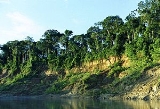
Manu River
Encyclopedia
The Manú is a river
in southeastern Peru
. It runs down the eastern slopes of the Andes
Mountains into the Amazon Basin
. It runs through the Manú National Park
, a vast Biosphere Reserve
, home to arguably the highest concentration of biodiversity
on Earth. Few people live along its length. Much of the park is off-limits to all but permitted scientists and the indigenous groups of Amazonian Indians, mostly of the Machiguenga
tribe. The Manú is a tributary to the Madre de Dios River
.
River
A river is a natural watercourse, usually freshwater, flowing towards an ocean, a lake, a sea, or another river. In a few cases, a river simply flows into the ground or dries up completely before reaching another body of water. Small rivers may also be called by several other names, including...
in southeastern Peru
Peru
Peru , officially the Republic of Peru , is a country in western South America. It is bordered on the north by Ecuador and Colombia, on the east by Brazil, on the southeast by Bolivia, on the south by Chile, and on the west by the Pacific Ocean....
. It runs down the eastern slopes of the Andes
Andes
The Andes is the world's longest continental mountain range. It is a continual range of highlands along the western coast of South America. This range is about long, about to wide , and of an average height of about .Along its length, the Andes is split into several ranges, which are separated...
Mountains into the Amazon Basin
Amazon Basin
The Amazon Basin is the part of South America drained by the Amazon River and its tributaries that drains an area of about , or roughly 40 percent of South America. The basin is located in the countries of Bolivia, Brazil, Colombia, Ecuador, Guyana, Peru, and Venezuela...
. It runs through the Manú National Park
Manú National Park
Manú National Park is a biosphere reserve located in Madre de Dios and Paucartambo, Cusco. Before becoming an area protected by the Peruvian government, the Manú National Park was conserved thanks to its inaccessibility. The park remains fairly inaccessible by road to this day. In 1977, UNESCO...
, a vast Biosphere Reserve
Biosphere reserve
The Man and the Biosphere Programme of UNESCO was established in 1971 to promote interdisciplinary approaches to management, research and education in ecosystem conservation and sustainable use of natural resources.-Development:...
, home to arguably the highest concentration of biodiversity
Biodiversity
Biodiversity is the degree of variation of life forms within a given ecosystem, biome, or an entire planet. Biodiversity is a measure of the health of ecosystems. Biodiversity is in part a function of climate. In terrestrial habitats, tropical regions are typically rich whereas polar regions...
on Earth. Few people live along its length. Much of the park is off-limits to all but permitted scientists and the indigenous groups of Amazonian Indians, mostly of the Machiguenga
Machiguenga
The Machiguenga are an indigenous people of the Amazon Basin jungle regions of southeastern Peru, east of Machu Picchu and close to the borders of Bolivia and Brazil. The people are short, but stoutly built, with broad facial features, and very rarely overweight...
tribe. The Manú is a tributary to the Madre de Dios River
Madre de Dios River
The Madre de Dios River, homonymous to the Peruvian region it runs through, then becomes the Beni River in Bolivia and then turns northward into Brazil, where it is called the Madeira River...
.

